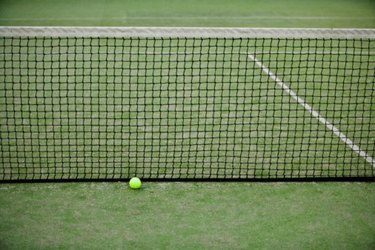Things You'll Need
Pruning shears
Pressure washer
Salt
Sodium chlorate
Power rake

Watch out for moss on tennis courts. Not only does it cause unsightly green blotches, it's also slippery and can cause injury to players. Tennis courts have three main surface types: asphalt, clay and grass. Moss occurs on each, growing through cracks in asphalt surfaces, creating a film with algae on clay and sprouting in damp areas of grass. The presence of moss means there's too much damp in the general area and too little light.
Step 1
Walk the perimeter of your tennis court. If shrubs or trees are shading the court for most hours of the day, they're creating good conditions for moss growth. Cut back shrubs and trees to allow more light to reach the court's surface. Lack of moisture helps but does not not kill moss, as moss reproduces through spores that can live for a long time in adverse conditions.
Video of the Day
Step 2
Examine the court's surface. If it's asphalt and moss is growing through cracks and fissures, it may be time to pressure-wash the court. Rent a pressure washer and make long passes along the surface, from one side to the other. Water under high pressure will blow out plants and spores. If you don't want to go to that extreme, sprinkle salt on the cracks and water it in. Moss cannot survive in saltwater.
Step 3
Look for sources of moisture in the surface of the court. If it's clay, which naturally holds water, Michigan State University recommends applying sodium chlorate to kill moss and keep it from coming back for two to three months. Read packaging instructions for proper proportions for the size of the court.
Step 4
Consider renovating if you have a moss problem in a grass tennis court. Dethatch the court with a power rake to cultivate and aerate the compacted soil that hurts grass growth and allows moss to take over. Moss will not grow in freshly cultivated, well-drained soil, but grass will. If grass can get a stronger foothold, it will crowd out moss when it sprouts from spores.
Video of the Day